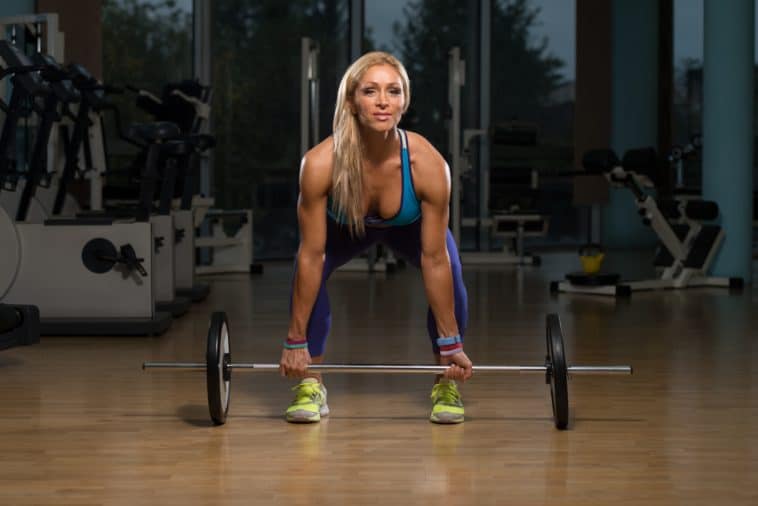What is the Barbell row?
The bent over barbell row is a staple exercise that primarily targets the muscles in the back, particularly the upper back muscles.
It is performed by bending over at the waist with a slight bend in the knees, while holding a barbell with an overhand grip.
The row movement involves pulling the weight towards either your chest or lower belly region, squeezing the shoulder blades together, and then slowly lowering the weights back down in a controlled manner.
This exercise is commonly included in strength training routines as it helps to develop a strong and muscular back. It also engages the biceps, forearms, and core to a lesser degree.
The bent over row is an effective way to improve posture, strengthen the back muscles, and enhance overall upper body strength.
What Muscles Does the Barbell Row Target?
The barbell row is an effective strength training exercise that primarily targets the muscles in the upper back and core region.

Specifically it focuses on the latissimus dorsi or “lats” which are the largest muscles in the back responsible for pulling movements.
The row also engages the rhomboids, trapezius, and rear deltoids, which play a significant role in retracting and stabilizing the shoulder blades.
Additionally, the barbell row activates the biceps and forearm muscles as secondary movers. This compound exercise also recruits the core muscles to provide stability and support during the movement.
To execute the barbell row correctly one must be maintaining a neutral spine and squeezing the shoulder blades together throughout the movement. This will ensure good posture and avoid injuries such as chronic back pain.
By incorporating the barbell row into your workout routine you can effectively strengthen and develop the muscles in your upper back, enhancing your overall posture and upper body strength.
How Do You Perform The Bent Over Barbell Row?
- Have a loaded barbell below you just like you would for a deadlift
- Bend down the same way as in the deadlift in order to grab the bar
- The difference between this and the deadlift is you will not stand all the way up once you pick up the bar you will stop while your knees are slightly bent and your back is still at least a 45-degree angle
- While in this bent-over position while keeping your back in that roughly 45-degree angle bring the barbell towards your belly button or lower chest
- Once it touches your body lower it until your arms are straight again
- Keep doing this movement until your set is complete
Why Should The Barbell Row Be Alternated Out?

The bent-over barbell row may seem like a staple exercise for building a strong back but alternating it out once in a while can actually be beneficial.
When performing the barbell row the main muscle group being targeted is the back, specifically the lats, rhomboids, and traps. However, constantly repeating the same exercise can lead to overuse injuries and muscle imbalances.
By performing an alternative to the barbell row such as the dumbbell row or cable row, different muscle groups can be engaged or the same muscles in different ways further making them developed, leading to a more well-rounded back.
Alternative exercises can target different angles and provide a different range of motion, which can further challenge the muscles and lead to better overall strength and development.
Overall alternating the barbell row out of the workout routine can help prevent injuries and promote better muscle balance and development as well as being effective at breaking through plateaus.
Barbell Row Alternatives For Back Development
Inverted Row
The inverted row is a great bodyweight exercise for working your back muscles especially the upper back.
To perform this exercise, you’ll need a horizontal bar that can support your body weight, like a pull-up bar or a Smith machine bar. Or even household items like a broomstick.
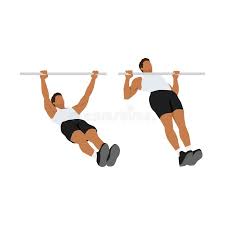
- Start by lying on your back under the bar with your feet flat on the ground and your hands gripping the bar shoulder-width apart. Keep your body in a straight line from your head to your heels
- Engage your core and pull your chest up to the bar keeping your elbows close to your body. Pause at the top for a moment before slowly lowering yourself back down
- Avoid letting your hips sag or your body twist. Repeat for the desired number of reps
- You can make the exercise harder by elevating your feet on a bench or performing a single-arm variation
The inverted row is a great exercise for building a strong back without the need for heavy weights or fancy equipment.
Dumbell Row

- Use the exact same instructions as the bent-over row replacing the barbell with two dumbbells instead
- Since you are using dumbbells you can hold them to where the grip is neutral (verticle) if so desired
T Bar Row
This exercise is done with a barbell and a T bar row platform. If you do not have access to a T bar row platform a corner between walls could work but keep in mind this may scratch your walls
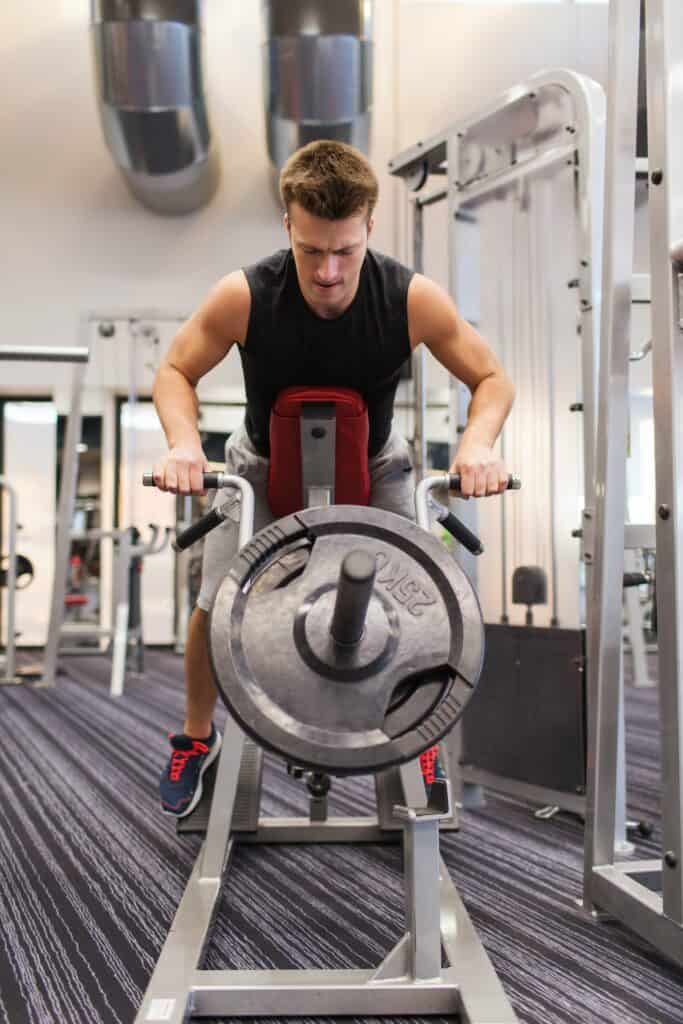
- Place one end of your barbell into the T bar row platform or tight into the corner
- Proceed to load the other end of barbell with the desired amount of weight
- Grab a form of straight bar attachment and place that grip under the bar right underneath where you loaded your weight
- The grip should now be in such a position to where when you pull on the grip it will pull up on the end of the bar and attached weight as well
- While holding the grip ensure your knees are bent and your back is at about a 45-degree angle
- Keeping back straight and aligned with your head pull the barbell towards your body at about belly button level in turn also pulling the weight towards your body
- Keeping elbows tight to your side slowly lower the bar until your arms are straight again
- Repeat movement for the desired amount of reps
Landmine Row
For this exercise you will need access to a landmine which is securely attached to the floor.
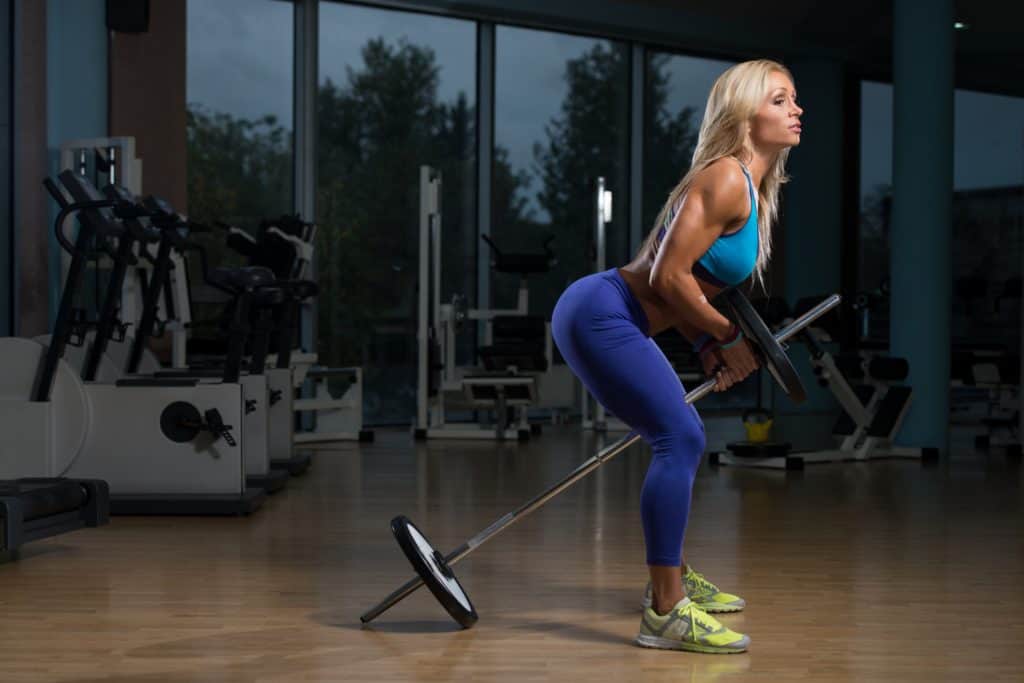
Like the t-bar row if you do not have access to a landmine a corner between walls could work but keep in mind this may scratch your walls.
- Place one end of your barbell into the landmine or tight into the corner
- Proceed to load the barbell with the desired amount of weight
- Grab a desired grip I recommend the V grip and place that grip under the bar right underneath where you loaded your weight
- The grip should now be in such a position to where when you pull on the grip it will pull up on the end of the bar and attached weight as well
- While holding the grip ensure your knees are bent and your back is at about a 45-degree angle
- Keeping your back straight and aligned with your head pull the grip towards your body at about belly button level in turn also pulling the weight towards your body
- Keeping elbows tight to your side slowly lower the bar until your arms are straight again
- Repeat movement for the desired amount of reps to really develop the lats and upper back
Meadows Row
A bit of a landmine row variation this exercise is prepared the same way the landmine row exercise is prepared. Using a landmine or corner for your barbell and loading the weight the same.
- Instead of grappling a suitable grip for this exercise the end of the barbell that is used to load your weight will serve as the grip
- During a typical landmine row one would stand parallel to the barbell and row but for this exercise you should stand perpendicular to the barbell
- While perpendicular to the loaded barbell now grab the end of the barbell with one hand get into a bent-over position and row away
Incline Bench Row
- This exercise will be done while laying belly flat on a bench set to your desired level of incline
- Have a loaded barbell ready on the floor not far in front of you
- With your belly flat against the bench and legs planted on the ground lean over and grab the barbell in front of you with the desired grip
- If you can not reach the barbell while laying on the bench you may have to pick it up beforehand and lift it over the top part of the bench while you rest your front side against the bench
- Holding the barbell straight in front of you with a grip slightly outside of shoulder width pull the barbell bringing it closer to the bench as close as you can pull it
- Slowly lower it again until your arms return to a straight position
- Repeat this movement for the desired amount of repetitions
Another possible variation is the incline dumbbell row performed with dumbells instead of a barbell
Seated Cable Row
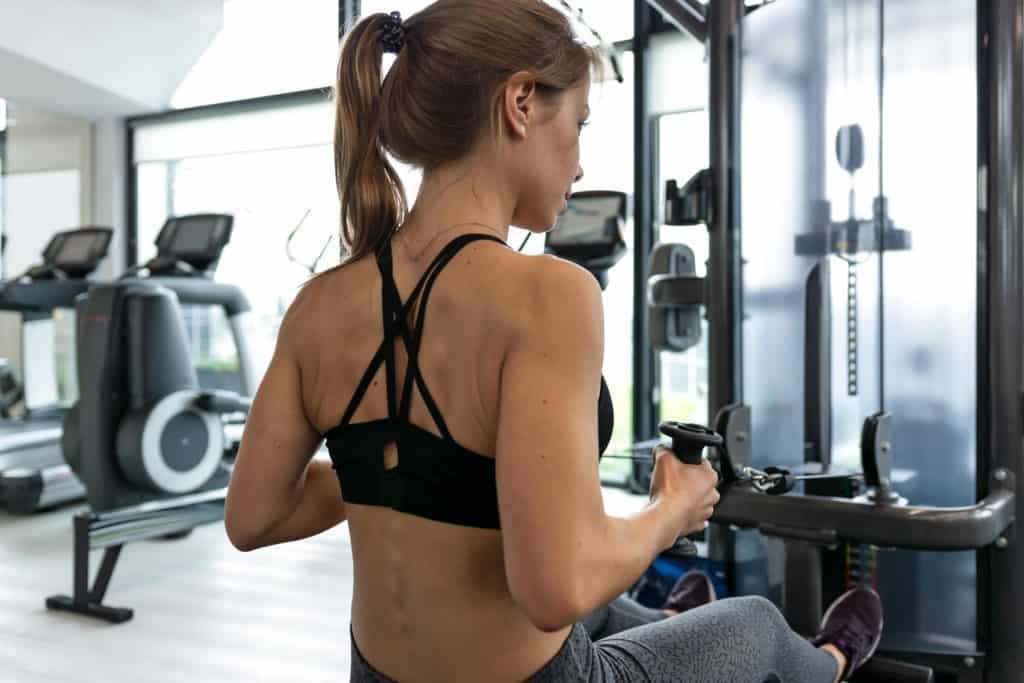
- For the seated row you will need a cable row machine which is quite common
- Sitting upright on the machine attach the desired grip to the cable
- Rest both feet on the appropriate rest platforms (if there do not happen to be any you may need to rest them on the floor)
- With feet rested grab the cable and attached grip
- While keeping your arms straight ensure you are sitting upright while holding the grip keeping your back straight up and in line with your neck
- Push through your legs and pull your arms towards your stomach while maintaining posture and keeping elbows tight to your side
- Slowly let the cable pull you back to where your arms are straight again
- Repeat the exercise for the desired number of repetitions
Machine Row
My pick for the greatest row variation as there are many versions of a machine row but this is due to there being many different makes of rowing machines
- A rowing machine often requires you to sit down and have your chest and stomach pushed up against a pad
- While seated both arms can be reached out to grip whatever form of grip is provided
- Then a slow rowing motion can be performed with both arms at the same time to achieve maximal back activation
A great thing about these machines is they usually have an adjustable seat so you can adjust to either perform a really high row or low row
Yates Row
The Yates row named after famous classic bodybuilder Dorian Yates is a simple variation of the bent over barbell row which Yates attributes to the spectacular development of the muscles in his back.
- This exercise is not complicated as it is simply a bent over barbell row performed with an underhand/supinated grip
- The other key feature of the Yates row is that during the concentric the barbell is kept as close to the body as possible and grasses along the things almost as if it is a dragging row
- The Yates row puts great emphasis on the muscles in the lower back as well as being one of the best exercises for bicep tension
- Another thing to keep in mind which Yates was really adamant about is that the elbows should always be as close to the body as possible and never leave your side
Rack Row
- Another not to complicated alternative to the bent-over barbell row the rack row involves a barbell row performed off of a rack
- Instead of having the starting position with the barbell on the floor the barbell is elevated usually hanging across a squat rack(Not too high though or it will be near impossible to perform a row)
- The barbell is usually elevated anywhere from shin to just above knee level
- The benefit of this is there is a tremendous increase in the amount of weight you can row doing the exercise thus leading to incredible overload, especially in the lats and lower back
- The rack row is definitely the go-to exercise on this list when looking to build a stronger back
The rack row is definitely the go-to exercise on this list when looking to build a stronger back
Resistance Band Row

- To perform a resistance band row any form of resistance band can be used
- The only other thing you will need is an anchoring point for your band this can be a door frame with a closed door or even just yourself stepping on top of the band using your feet to keep it down
- Wherever you have your band anchored you can go ahead and row nonetheless
- If you are stepping on it you will want to bend over at least 45 degrees
- If you are using some form of a wall anchor you can just stay standing as long as your torso is perpendicular to your rowing path and your back stays straight on course
Towel Row
A towel row is exactly what it sounds like it is. A row but performed with a towel. Because all you need is a towel this exercise can be performed anywhere.
- It is typically done with one’s back straight and as parallel to the floor as possible
- While maintaining your straight posture fully extend your arms toward the ground holding one end of each end of rope in both hands
- The key to creating resistance during this exercise is to pull each end of the towel apart from the other as hard as you can while maintaining proper form pulling through the entire range of motion
- With this in mind begin to perform rows maintaining your grip through the whole exercise and also ensuring elbows are kept as close to the side of the body as possible and do not flare to the sides
- The total lack of equipment makes the towel row an excellent alternative to the barbell row
Are These Barbell Row Alternatives Effective?
When it comes to building strength and muscle in the upper back, the barbell row is one of the go-to exercises for many lifters.
However, if you don’t have access to a barbell or are looking to switch things up this is when finding alternatives to barbell rows is important and alternatives that can give you similar results.
Effective barbell row alternatives such as the cable row and the single-arm dumbbell row really allow for a greater range of motion and isolation of the back and lats.
This exercise targets the back and lats and also engages the core for stability. It is important to note that proper form is crucial for any rowing exercise to be effective and safe.
Ensuring a neutral spine, engaging the back muscles, and maintaining control throughout the movement is key.
So, if you are looking to change up your back routine or do not have access to a barbell these barbell row alternatives can be effective in helping you build strength and muscle in the upper back.

